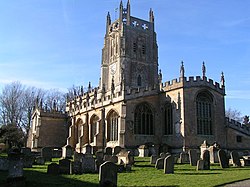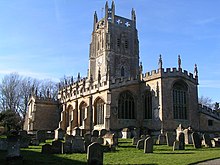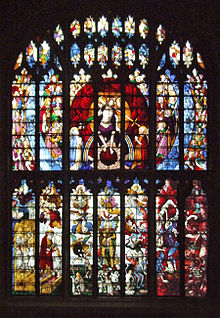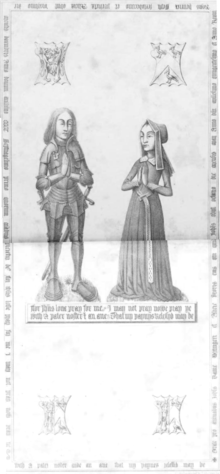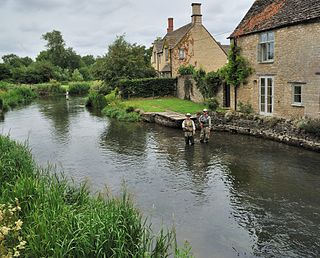
Fairford is a town in Gloucestershire, England. The town lies in the Cotswold hills on the River Coln, 6 miles (9.7 km) east of Cirencester, 4 miles (6.4 km) west of Lechlade and 9 miles (14 km) north of Swindon. Nearby are RAF Fairford and the Cotswold Water Park.
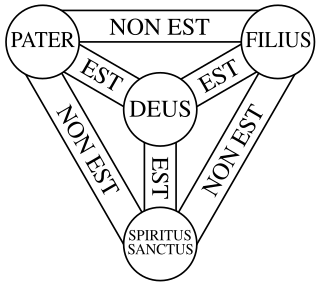
The Shield of the Trinity or Scutum Fidei is a traditional Christian visual symbol which expresses many aspects of the doctrine of the Trinity, summarizing the first part of the Athanasian Creed in a compact diagram. In late medieval Europe, this emblem was considered to be the heraldic arms of God.

Thomas Willement was an English stained glass artist, called "the father of Victorian stained glass", active from 1811 to 1865.

St Mary's Priory Church, Deerhurst, is the Church of England parish church of Deerhurst, Gloucestershire, England. Much of the church is Anglo-Saxon. It was built in the 8th century, when Deerhurst was part of the Anglo-Saxon kingdom of Mercia. It is contemporary with the Carolingian Renaissance on mainland Europe, which may have influenced it.

St. Mary's Church, Broadwater, is a Church of England parish church in the Worthing Deanery of the Diocese of Chichester. It serves the ecclesiastical parish of Broadwater, West Sussex and is named after St. Mary. St Mary's is one of several sites in this benefice along with Queen Street and St. Stephen's.

The Church of St. John Baptist, Cirencester is a parish church in the Church of England in Cirencester, Gloucestershire, England. It is a Grade I listed building.

Holy Trinity Church is a redundant Anglican church on Low Lane in the village of Wensley, North Yorkshire, England. The building is recorded in the National Heritage List for England as a designated Grade I listed building, and is under the care of the Churches Conservation Trust. Alec Clifton-Taylor included the church in his list of 'best' English parish churches.

The Church of St Mary the Virgin is a Church of England parish church in Meysey Hampton, Gloucestershire. It is in the Diocese of Gloucester and the archdeaconry of Cheltenham. It is a Grade II* listed building.
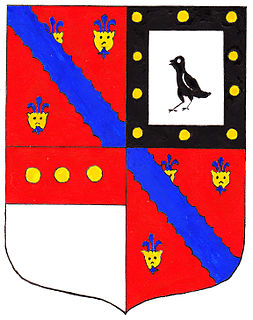
Sir William Denys (1470–1533) of Dyrham, Gloucestershire, was a courtier of King Henry VIII and High Sheriff of Gloucestershire in 1518 and 1526.
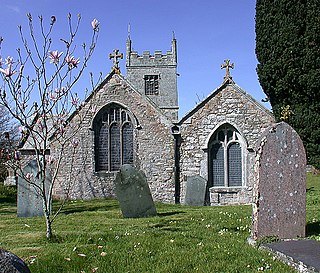
Colan Church also known as St Colan Church is a 13th-century church in Colan, mid-Cornwall, UK. Dedicated to St Colanus, it became a Grade I listed building in 1967. The vicars of St Columb Minor have served the church since the middle of the 20th century.
Hilary Godwin Wayment OBE, FSA (1912–2005) was a British author and historian of stained glass.
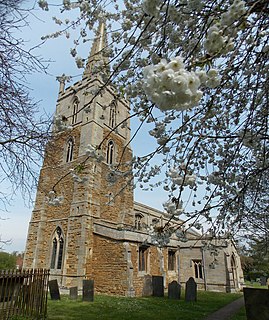
St Mary and St Peter's Church is a Grade I listed Church of England parish church dedicated to Saint Mary and Saint Peter in Harlaxton, Lincolnshire, England. The church is 2 miles (3 km) south-east from Grantham, and at the eastern edge of the Vale of Belvoir in South Kesteven.

Thomas Peyton (1418–1484) of Isleham, Cambridgeshire, was twice Sheriff of Cambridgeshire and Huntingdonshire, in 1443 and 1453. He rebuilt the church of St Andrew's in Isleham, in the chancel of which survives his monumental brass. He is depicted in a 1485 stained glass window in Long Melford Church, Suffolk, where he displays on his surcoat the Peyton arms: Sable, a cross engrailed or a mullet in the first quarter argent.

The Church of All Saints in Radwell in Hertfordshire is an Anglican parish church which falls within the Diocese of St Albans. It is a Grade II* listed building, having gained that status in 1968.
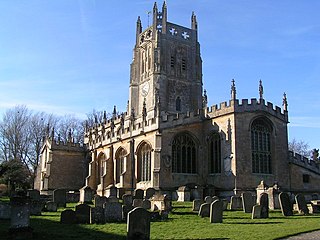
The Fairford stained glass is a set of 28 pre-Reformation stained glass windows located in St Mary's Church, Fairford, Gloucestershire. The medieval stained glass panes are of national historical and architectural importance as they constitute what is "probably the most complete set of medieval stained glass in Britain" consisting of 28 windows displaying biblical scenes. They were added after the church had been rebuilt by the wealthy wool merchant John Tame (c.1430–1500). The glass was made between 1500 and 1517 under the instructions of his son, Edward Tame.
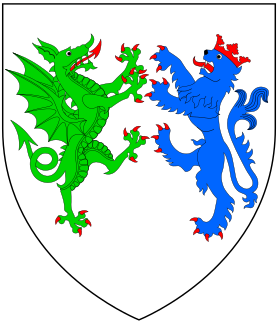
John Tame of Cirencester and of Beauchamp Court in the parish of Fairford, both in Gloucestershire, England, was a wealthy wool producer and merchant who re-built the surviving St. Mary's Church, Fairford, the former structure of which had been built by one of the Beauchamp Earls of Warwick in the 15th century. The 28 Fairford stained glass windows he installed in the church are considered amongst the finest and most complete in England. He and his son Sir Edmund Tame (d.1534) so fostered the trade transacted at Fairford, that it came to rival that of the nearby long-established town of Cirencester, which increase was remarked upon by his contemporary the antiquary John Leland (d.1552): "Fairford never flourished afore the cumming of the Tames into it".

John Twynyho of Cirencester, Bristol and Lechlade, all in Gloucestershire, was a lawyer and wealthy wool merchant who served as Recorder of Bristol, as a Member of Parliament for Bristol in Gloucestershire in 1472-5 and in 1484 and for the prestigious county seat Gloucestershire in 1476. In 1478 he was Attorney General to Lord Edward, eldest son and heir of King Edward IV.

St Peter and St Paul is a Grade I listed Church of England parish church in East Harling, Norfolk. It is part of Harling United Benefice, a group of five churches that also includes, St Andrew, Brettenham, St Mary, Bridgham, St Ethelbert, Larling and St John the Evangelist, Rushford.
